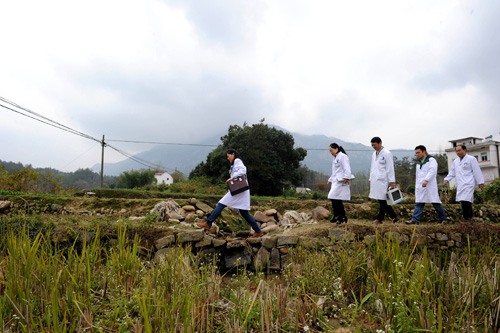

MEDICAL VOLUNTEERS: A medical team from a hospital of Hefei, capital of east China's Anhui province, offers service to residents in mountains in Yuexi County of the province on November 11, 2014 (XINHUA)
As part of the local authorities' poverty alleviation efforts, many such hillside lands have been turned into pastures for the villagers to breed their own sheep or cattle.
"I feel much more relaxed now than in the past," Gao said. "We used to plant corn but could only fill our stomachs without saving a cent."
Raising sheep not only frees his family from laborious work in the cornfields, but also brings in 30,000-40,000 yuan ($4,878-6,504) a year to the four-member family. Such a household income is high enough to lift Gao's family out of poverty.
By the end of 2010, China had managed to reduce the impoverished rural population, which lacked food and clothing, from 250 million to 26.88 million, which in turn lowered the percentage of rural residents in poverty from 30.7 percent to 2.8 percent, according to a paper released by the Chinese Academy of Social Sciences (CASS) in 2011.
The country has also made outstanding contributions to global poverty alleviation efforts, accounting for 76.88 percent of the total reduction in the number of people living in poverty globally between 1990 and 2005, according to statistics from the UN Development Program.
"China's economic success is the key factor in reducing the country's poverty population during the past 30 years," said Li Xiaoyun, a professor with Beijing-based China Agricultural University.
He said increasing agricultural productivity resulted in a rise in farmers' incomes, and the development of small and medium-sized enterprises prompted the migration of rural labor forces to cities, where salaries also increased income for families left behind in rural areas.
"Although the rich in China are reaping more benefits, the country's economic success still has great potential to further reduce poverty in most areas in China's relatively poor central and western regions," Li said.
Along with overall GDP growth targets, the government is now focusing on raising the income of the country's population with a current goal to double per-capita income from those recorded in 2010 by 2020.
In an effort to expand the safety net for those in poverty, the Chinese Government raised the poverty threshold to 2,300-yuan ($374) annual net income of farmers in 2011, a 92-percent increase from the standard set in 2009 at 1,196 yuan ($194).
As per the new standard, an estimated 128 million rural residents were living in poverty at the end of 2011, accounting for 13.4 percent of the total rural population.
"The previous poverty line underestimated the number of poor people in rural China," said Wang Sangui, a professor at the School of Agricultural Economics and Rural Development of the Beijing-based Renmin University of China. "Only 2.8 percent of the rural population was officially considered poor, which was lower than many developed countries such as the United States, which has a poverty rate of about 15 percent."
Wang believes the new poverty standard better reflects the situation in China and will bring more resources to poverty-stricken regions.
In the following two years, China further lowered its population living under the state poverty line of 2,300 yuan per capita a year to 82.49 million by the end of 2013, according to LGOPAD figures.
A lasting battle
In a teleconference on October 17 last year, the country's first Poverty Relief Day, Chinese President Xi Jinping pledged to make continued efforts to fight poverty. He asked authorities to mobilize all social forces to join the war against poverty, as the most arduous task in building a well-off society is raising the poor out of poverty.
China should continue innovating and take differentiated and targeted steps to deliver more people from hunger, Xi said.
Although some 660 million people were lifted out of poverty between 1978 and 2010, some 82.49 million people remain in poverty in rural areas as of the end of 2013, according to official data.
Zheng Wenkai, Deputy Director of the LGOPAD, said at a press conference in Beijing that poverty is still a salient problem in China.
"As of the end of 2013, demographically, 82.49 million people are still trapped in poverty according to China's poverty line, and 200 million according to the international one," he said.
Copyright ©1999-2018
Chinanews.com. All rights reserved.
Reproduction in whole or in part without permission is prohibited.